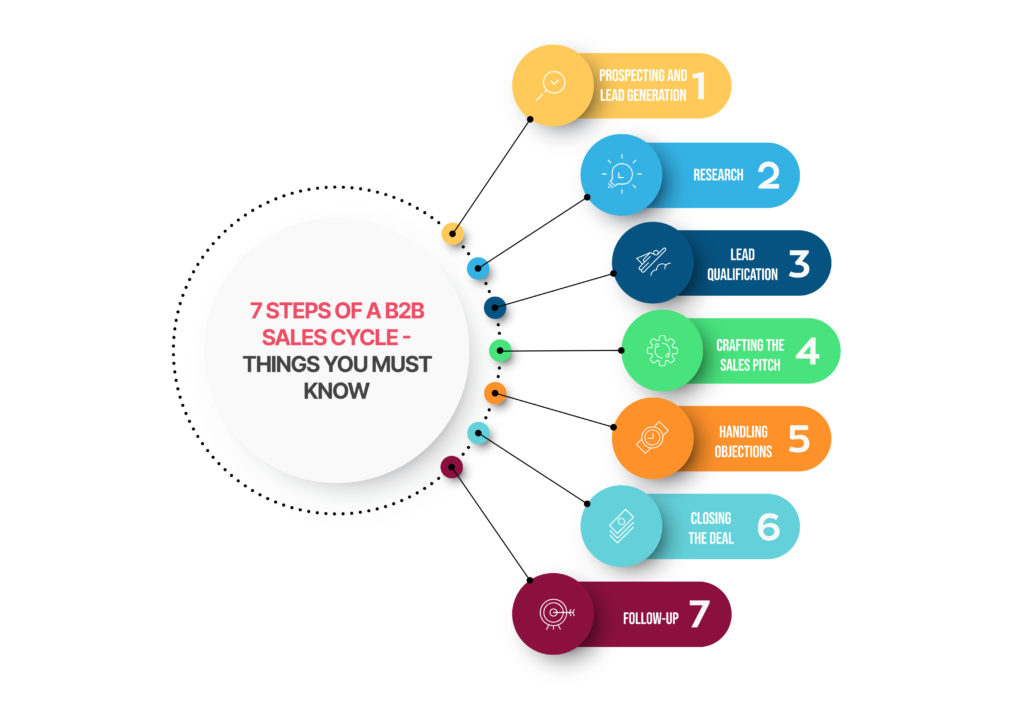The sales process is a systematic approach to converting leads into customers. It typically involves a series of steps, such as prospecting, qualifying leads, presenting your product or service, handling objections, and closing the deal.
The 7-step sales process is a tried-and-true method that has been used by successful B2B companies for years. It is a flexible process that can be adapted to the specific needs of your business.

Here are the 7 steps of the sales process:
Each step is important, and the success of the overall sales process depends on the quality of each step.
1. Preparation and research
The first step in the sales process is to prepare and research. This involves understanding your product or service, your target market, and your competitors. You should also research the specific needs of your potential customers.
To do this, you can:
- Read industry publications
- Attend industry events
- Talk to your customers and prospects
- Use social media
- Conduct market research
The more you know about your product, your market, and your customers, the better prepared you will be to sell.
2. Prospecting
Once you have prepared and researched, you need to start prospecting for potential customers. This involves identifying and qualifying potential customers who are likely to be interested in your product or service.
There are many different ways to prospect, such as:
- Cold calling
- Email marketing
- Networking
- Attending trade shows
- Using social media
The best way to prospect will depend on your industry and your target market.
3. Need assessment
Once you have identified potential customers, you need to conduct a need assessment. This involves understanding the specific needs of your potential customers and how your product or service can meet those needs.
To do this, you can:
- Ask questions
- Listen carefully
- Observe the customer’s environment
- Use empathy
The more you understand about the customer’s needs, the better you will be able to sell your product or service.
4. Pitch/presentation
Once you have conducted a need assessment, you need to deliver a pitch or presentation that highlights the benefits of your product or service and how it can meet the customer’s needs.
Your pitch or presentation should be clear, concise, and persuasive. It should also be tailored to the specific needs of the customer.
5. Objection handling
No sales process is perfect. There will be times when potential customers raise objections to your product or service. It is important to be prepared to handle these objections professionally and effectively.
There are many different ways to handle objections. Some common techniques include:
- Addressing the objection directly
- Asking clarifying questions
- Offering a solution
- Building rapport
- Overcoming the objection with a strong benefit
6. Closing
The goal of the sales process is to close the deal. This means getting the customer to commit to buying your product or service.
There are many different ways to close a sale. Some common techniques include:
- Asking for the sale
- Using a call to action
- Creating a sense of urgency
- Overcoming the customer’s final objections
7. Follow-up, repeat business, and referrals
Even after you have closed the sale, the sales process is not over. You need to follow up with the customer to ensure that they are satisfied with your product or service. You should also try to get repeat business and referrals from the customer.
To do this, you can:
- Send thank-you notes
- Stay in touch with the customer
- Offer support and assistance
- Ask for referrals
The 7-step sales process is a valuable tool for any B2B company. By following these steps, you can increase your chances of converting leads into customers and growing your business.

Additional tips for a successful B2B sales process in 2023
- Use technology to automate tasks and streamline the sales process. There are many CRM (customer relationship management) tools available that can help you manage your leads, track your progress, and automate tasks.
- Personalize your outreach and communications. This means using the customer’s name, addressing their specific needs, and using language that they will understand.
- Focus on building relationships with potential customers. This takes time and effort, but it is essential for building trust and rapport.
- Be prepared to adapt your sales process to the specific needs of each customer. No two customers are the same, so it is important to be flexible and adaptable.
- Track your results and make adjustments as needed. This will help you identify what is working and what is not, so you can make improvements to your sales process.
Follow Leveledge Blogs for more informative Blogs: https://leveledge.in/blog



